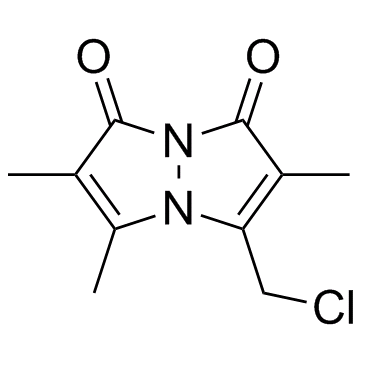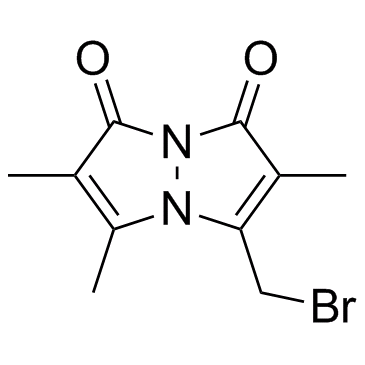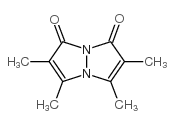Monochlorobimane

Monochlorobimane structure
|
Common Name | Monochlorobimane | ||
|---|---|---|---|---|
| CAS Number | 76421-73-3 | Molecular Weight | 226.66000 | |
| Density | 1.4g/cm3 | Boiling Point | 314.9ºC at 760 mmHg | |
| Molecular Formula | C10H11ClN2O2 | Melting Point | 135-136ºC(lit.) | |
| MSDS | Chinese USA | Flash Point | 144.2ºC | |
| Symbol |

GHS07 |
Signal Word | Warning | |
Use of MonochlorobimaneMonochlorobimane is a fluorescent dye (λex=380 nm, λem=470 nm). |
| Name | monochlorobimane |
|---|---|
| Synonym | More Synonyms |
| Description | Monochlorobimane is a fluorescent dye (λex=380 nm, λem=470 nm). |
|---|---|
| Related Catalog | |
| In Vitro | A common technique to measure Glutathione (GSH) in cultured cells is to add Monochlorobimane to the culture medium where it readily enters cells to form a fluorescent GSH-monochlorobimane adduct that can be measured fluorometrically. It is clear that the Monochlorobimane approach gives comparable results to the HPLC technique. Although most laboratories use 100 mM Monochlorobimane in their assay our results show that the Monochlorobimane concentration can be lowered to 25 mM and still accurately measure homogenate GSH content[1]. |
| Kinase Assay | Monochlorobimane (mCB) is added to the second half liver tissue homogenate to a final concentration of 100 mM along with glutathione S-transferase (1 U/mL) obtained from equine liver; the homogenate is then allowed to incubate at room temperature for 30 min. The Glutathione (GSH)-Monochlorobimane adduct is measured in a microtiter reader[1]. |
| References |
| Density | 1.4g/cm3 |
|---|---|
| Boiling Point | 314.9ºC at 760 mmHg |
| Melting Point | 135-136ºC(lit.) |
| Molecular Formula | C10H11ClN2O2 |
| Molecular Weight | 226.66000 |
| Flash Point | 144.2ºC |
| Exact Mass | 226.05100 |
| PSA | 42.96000 |
| LogP | 0.86100 |
| Index of Refraction | 1.61 |
| Symbol |

GHS07 |
|---|---|
| Signal Word | Warning |
| Hazard Statements | H315-H319-H335 |
| Precautionary Statements | P261-P305 + P351 + P338 |
| Personal Protective Equipment | dust mask type N95 (US);Eyeshields;Gloves |
| Hazard Codes | Xi: Irritant; |
| Risk Phrases | R36/37/38 |
| Safety Phrases | 26-36 |
| RIDADR | NONH for all modes of transport |
| HS Code | 2933990090 |
|
~62% 
Monochlorobimane CAS#:76421-73-3 |
| Literature: Kosower, Edward M.; Pazhenchevsky, Barak; Dodiuk, Hanna; Kanety, Hannah; Faust, Dov Journal of Organic Chemistry, 1981 , vol. 46, # 8 p. 1666 - 1673 |
|
~% 
Monochlorobimane CAS#:76421-73-3 |
| Literature: Kosower, Edward M.; Pazhenchevsky, Barak; Dodiuk, Hanna; Kanety, Hannah; Faust, Dov Journal of Organic Chemistry, 1981 , vol. 46, # 8 p. 1666 - 1673 |
|
~% 
Monochlorobimane CAS#:76421-73-3 |
| Literature: Kosower, Edward M.; Pazhenchevsky, Barak; Dodiuk, Hanna; Kanety, Hannah; Faust, Dov Journal of Organic Chemistry, 1981 , vol. 46, # 8 p. 1666 - 1673 |
| Precursor 3 | |
|---|---|
| DownStream 0 | |
| HS Code | 2933990090 |
|---|---|
| Summary | 2933990090. heterocyclic compounds with nitrogen hetero-atom(s) only. VAT:17.0%. Tax rebate rate:13.0%. . MFN tariff:6.5%. General tariff:20.0% |
|
A Synthetic Lethal Interaction between Glutathione Synthesis and Mitochondrial Reactive Oxygen Species Provides a Tumor-Specific Vulnerability Dependent on STAT3.
Mol. Cell. Biol. 35 , 3646-56, (2015) Increased production of mitochondrion-derived reactive oxygen species (ROS) is characteristic of a metabolic shift observed during malignant transformation. While the exact sources and roles of ROS in... |
|
|
Purification and characterization of the Staphylococcus aureus bacillithiol transferase BstA.
Biochim. Biophys. Acta 1840(9) , 2851-61, (2014) Gram-positive bacteria in the phylum Firmicutes synthesize the low molecular weight thiol bacillithiol rather than glutathione or mycothiol. The bacillithiol transferase YfiT from Bacillus subtilis wa... |
|
|
All-trans retinoic acid prevents oxidative stress-induced loss of renal tight junction proteins in type-1 diabetic model.
J. Nutr. Biochem. 26 , 441-54, (2015) We previously reported that diabetes decreased the expression of renal tight junction (TJ) proteins claudin-5 in glomerulus, and claudin-2 and occludin in proximal tubule through an oxidative stress d... |
| 7-(chloromethyl)-1,2,6-trimethylpyrazolo[1,2-a]pyrazole-3,5-dione |
| Chlorobimane |
| Monochlorobimane |


